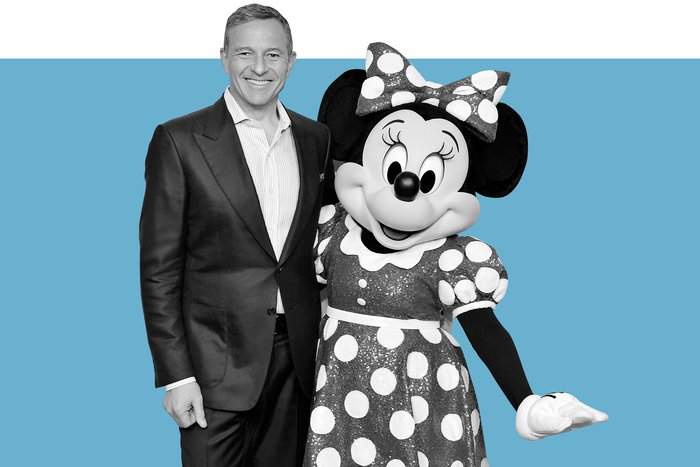迪士尼正在上演一部大片,,但地點不在電影院
|
4月中旬,,娛樂巨頭迪士尼舉辦了一場投資發(fā)布會,向投資界展示實力,,他們把位于加利福尼亞伯班克巨大的2號錄音棚(Soundstage 2)改成了一個為知識工作者設(shè)計的禮堂,,《歡樂滿人間》(Mary Poppins)和《加勒比海盜》(Pirates of the Caribbean)就是在這里誕生的。發(fā)布會以一個短片開場,,迪士尼把它幾十年來的電影電視劇以及21世紀??怂梗ㄋ罱?10億美元完成了收購)的片子剪輯在一起,讓華爾街人看得入了迷,。紀錄片《徒手攀巖》(Free Solo)里一個戲劇性的鏡頭構(gòu)成了這個視頻的重頭戲——該片由曾隸屬于??怂沟膰业乩砼臄z:充滿英雄氣概的亞歷克斯·霍諾爾德徒手攀在巖壁上,另外一位登山者吟誦道:“各行各業(yè)都在慢慢累積進步,。但每隔一段時間,,就會出現(xiàn)這樣標志性的飛躍?!?/p> 迪士尼的動作不是一小步,。迪士尼正在精心策劃瞄準互聯(lián)網(wǎng)流媒體市場的大跨步,在提供新產(chǎn)品的同時也因為要下架奈飛(Netflix)等競爭平臺上迪士尼的內(nèi)容放棄了每年幾十億美元的收入,。對于任何一家大公司而言,,都可以稱得上是多年來最大膽的嘗試——一家預(yù)計在2019財年收入720億美元的企業(yè)要轉(zhuǎn)換商業(yè)模式。 這些細節(jié)讓投資者驚嘆不已,,他們在活動結(jié)束后的幾天內(nèi)將迪士尼股價推高了13%,。該公司的新服務(wù)“迪士尼+”將于11月12日在美國推出。這項服務(wù)將向用戶打包提供迪士尼,、皮克斯,、漫威、盧卡斯電影和國家地理旗下浩如煙海的視頻內(nèi)容,,月度訂閱價僅需7美元——奈飛月費的一半——或者每年70美元,。迪士尼預(yù)計五年內(nèi)將擁有6000萬到9000萬用戶,其中三分之二來自國外,。長期擔任迪士尼首席執(zhí)行官卻出人意料地宣布將在2021年底合同到期時辭職的羅伯特·艾格吹噓道,,“沒有哪個平臺的內(nèi)容或哪家科技公司可以媲美”擁有《白雪公主》(Snow White),、《星球大戰(zhàn)》(Star Wars)全系列電影和30季《辛普森一家人》(The Simpsons)在內(nèi)的資源。 迪士尼的這種行為十分大膽,,代價也很高,。如果從競爭對手的平臺上下架迪士尼的內(nèi)容,該公司將立即減少25億美元的收入,。經(jīng)紀公司伯恩斯坦(Bernstein)的分析師托德·尤恩格認為,,代價其實更大。他估計合并后的迪士尼和??怂姑磕晗虬物w等平臺收取的特許使用費能高達80億美元,迪士尼最終將告別所有此類收入,。尤恩格還擔心,,與源源不斷產(chǎn)生新內(nèi)容的奈飛相比,迪士尼也會在這個領(lǐng)域受挫,。他說:“應(yīng)該不會有網(wǎng)站專門討論‘本周在迪士尼+上可以觀看哪些新內(nèi)容',。” |
On the mid-April day that Disney hosted a show-of-force presentation for investment analysts, the entertainment giant converted its cavernous Soundstage 2 in Burbank, Calif., where Mary Poppins and Pirates of the Caribbean came to life, into an auditorium for knowledge workers. Wall Street types sat rapt as Disney opened with a video splicing its decades-old film and TV library with that of 21st Century Fox, recently acquired for $71 billion. The key dramatic moment: a shot from the stunning rock climbing documentary Free Solo—from formerly Fox-owned National Geographic—with the heroic Alex Honnold perched untethered on the rock face, another climber intoning: “There’s incremental advances that happen in all kinds of things. But every once in a while, there’s just this iconic leap.” Subtle, it wasn’t. Disney is taking a meticulously planned leap itself into the market for Internet video streaming, simultaneously offering new products while forgoing billions of dollars in revenue by removing its content from rival entertainment platforms like Netflix. It is easily the boldest attempt in years by any established behemoth to shift its business model while operating an enterprise that’s forecast to bring in $72 billion in fiscal year 2019. The particulars wowed investors, who bid up Disney’s shares 13% in the days after the event. Its new service, Disney+, debuts Nov. 12 in the U.S. It will offer the prodigious libraries of its Disney, Pixar, Marvel, Lucasfilm, and National Geographic brands in one bundled service for $7 a month—half Netflix’s subscription price—or $70 a year. And Disney projected 60 million to 90 million subscribers in five years, two-thirds from outside the U.S. Longtime Disney CEO Robert Iger, who unexpectedly avowed he’ll step down when his contract expires in late 2021, bragged that “no content or technology company can rival” a catalog that includes Snow White, every Star Wars movie, and 30 seasons of The Simpsons. Disney’s move is bold—and costly. It will immediately forgo $2.5 billion in revenue by removing Disney content from rival services. Todd Juenger, an analyst with brokerage Bernstein, reckons the pain will be bigger. He estimates the combined Disney and Fox collect up to $8 billion annually from licensing revenue, including from Netflix, and that Disney will eventually say goodbye to all of it. Juenger also frets that Disney will suffer by comparison with Netflix’s constant influx of new material. “We don’t think there will be any websites dedicated to ‘What’s new to watch on Disney+ this week,’?” he says. |

|
迪士尼開場的定價策略讓人震驚,。獨立研究公司BTIG的分析師理查德·格林菲爾德認為這是個錯誤的定價。按照打折后的全年訂閱價來算,,格林菲爾德估計迪士尼每個訂閱用戶貢獻的收入約為6.25美元,。“這個價位上很難賺到錢”,,他總結(jié)道,。 也有人懷疑,認為迪士尼的低價戰(zhàn)略不會持續(xù)太久,,而且該公司同時能利用的財務(wù)杠桿還有好幾個,。迪士尼+只是其新戰(zhàn)略的一部分。收購??怂购?,迪士尼就擁有了正在快速增長的Hulu流媒體平臺,Hulu主要通過廣告和訂閱賺錢,。此外,,迪士尼的ESPN體育有線節(jié)目電視網(wǎng)也正在經(jīng)營同樣雄心勃勃的流媒體服務(wù)。 更何況,,迪士尼也沒打算停止從它最寶貴的資產(chǎn)中創(chuàng)造流媒體以外的營收——該公司大部分影片的首映仍將在院線推出,。 每個關(guān)注即將開啟的流媒體混戰(zhàn)的人都明白,消費者會在某個時刻出現(xiàn)“訂閱疲勞”,。亞馬遜的Prime Video,、蘋果即將推出的Apple+服務(wù),、奈飛以及康卡斯特(Comcast)的NBC Universal和AT&T旗下華納媒體(WarnerMedia)可能推出的產(chǎn)品將挑戰(zhàn)大部分追劇狂的容忍度。對于還沒切斷電視線的人來說,,除了有線電視和衛(wèi)星電視賬單,,他們要面臨的還包括這些平臺的賬單。 從迪士尼的角度來看,,它將最大程度地確保他們的平臺能夠成為用戶的選擇,。三個半小時的活動接近尾聲時,迪士尼+的市場營銷主管瑞奇·斯特勞斯告訴投資者:“對于迪士尼而言,,沒有哪項工作的優(yōu)先級比這個更靠前,。” 他說,,該公司將利用旗下的主題公園,、游輪、廣播網(wǎng)絡(luò)以及社交媒體和付費廣告來推廣迪士尼+,。 畢竟,,這個已經(jīng)有96年歷史的業(yè)內(nèi)標桿可不想在沒有安全網(wǎng)的情況下大膽嘗試壯舉。(財富中文網(wǎng)) 本文另一版本以《迪斯尼的最新大片不在電影院里》刊載于2019年5月的《財富》雜志上,。 譯者:Agatha |
Disney’s opening pricing gambit was shocking. Richard Greenfield, an analyst with independent research firm BTIG, thinks Disney made a mistake. Given the discounted annual price, Greenfield estimates Disney’s per-user revenue will be about $6.25. “It’s tough to make money at that level,” he concludes. Cynics assume Disney’s rock-bottom price won’t last, and the company has more than a few financial levers to pull in the meantime. Disney+ is just part of its new strategy. The Fox acquisition gives Disney control of the rapidly growing Hulu streaming service, which makes money from ads and subscriptions, to add to the similarly ambitious streaming service run by Disney’s ESPN sports franchise. Disney also has no plans to stop collecting non-streaming revenue from its biggest properties, most of which will continue to debut in movie theaters. Everyone watching the upcoming streaming fracas understands that at some point consumer “subscription fatigue” will set in. Amazon’s Prime Video, Apple’s upcoming Apple+ service, Netflix, and expected offerings from Comcast’s NBCUniversal and AT&T-owned ?WarnerMedia will all test the tolerance of the most avowed binge-watcher. That’s on top of cable and satellite bill s for those who haven’t yet cut the cord. For its part, Disney will apply maximum pressure to ensure its services are among those users choose. “There is no bigger priority for the Walt Disney Company going forward,” Ricky Strauss, head of marketing for Disney+, told investors near the end of the three-and-a-half-hour event. The company, he said, will push Disney+ in its theme parks, on its cruises, across its broadcast networks, and through social media and paid advertising. After all, the 96-year-old industry icon has no intention of attempting a daring feat without a safety net. A version of this article appears in the May 2019 issue of Fortune with the headline, “Disney’s Latest Blockbuster Isn’t in Theaters.” |













